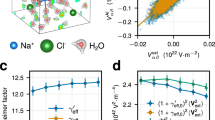Abstract
By the interpretation of the intermolecular nuclear magnetic relaxation rate of 19F the orientation of the water molecules in the hydration sphere of F− can be determined. Similarly, the orientation of the water molecules around the methyl group of propionic acid in aqueous solution has been studied. Experiments are described which give information about the nature of association of solute in aqueous solution of a number of carboxylic acids and of ethanol. The local dynamic details of the I− ion have been investigated. Some new results are briefly discussed regarding the nuclear magnetic relaxation by quadrupole interaction in electrolyte solutions.
This paper was presented at the symposium, “The Physical Chemistry of Aqueous Systems,” held at the University of Pittsburgh, Pittsburgh, Pennsylvania, June 12–14, 1972, in honor of the 70th birthday of Professor H. S. Frank.
Access this chapter
Tax calculation will be finalised at checkout
Purchases are for personal use only
Preview
Unable to display preview. Download preview PDF.
Similar content being viewed by others
References
A. Abragam, The Principles of Nuclear Magnetism (Oxford University Press, 1961).
T. C. Farrar and E. D. Becker, Pulse and Fourier Transform NMR (Academic Press, New York and London, 1971).
H. G. Hertz and C. Rädle, Ber. Busenges. Physik. Chem. (1973), in press.
R. Göller, H. G. Hertz, and R. Tutsch, Pure Appl Chem. 32, 148 (1972).
H. G. Hertz and R. Tutsch, to be published.
A. Geiger and H. G. Hertz, to be published.
K. Hermann and H. G. Hertz, to be published.
H. G. Hertz, M. Holz, G. Keller, H. Versmold, and C. J. Yoon, to be published.
G. H. F. Diercksen and W. P. Kraemer, Chem. Phys. Letters 5, 570 (1970).
P. Russegger, H. Lischka, and P. Schuster, Theor. Chim. Acta 24, 191 (1972).
E. v. Goldammer and M. D. Zeidler, Ber. Bunsenges. Physik. Chem. 73, 4 (1969).
E. v. Goldammer and H. G. Hertz, Phys. Chem. 74, 3734 (1970).
M. Grüner and H. G. Hertz, Advan. Mol. Relaxation Processes 3, 75 (1972).
H. G. Hertz, R. Tutsch, and H. Versmold, Ber. Bunsenges. Physik. Chem. 75, 1177 (1971).
A. S. Golik, A. W. Orishchenko, and A. J. Artemchenko, Dopovidi Akad. Nauk. Ukr. RSR, 453 (1954).
H. T. Briscoe and W. R. Rinehart, J. Phys. Chem. 46, 387 (1942).
G. Engel and H. G. Hertz, Ber. Bunsenges. Physik. Chem. 72, 808 (1968).
H. G. Hertz, to be published.
H. G. Hertz, Z. Elektrochem. 65, 20 (1961).
K. A. Valiev, Zh. Eksper. i Teor. Fiz. 37, 109 (1959)[Sov. Phys. JETP 106, 77 (I960)].
K. A. Valiev and B. M. Khabibullin, Zh. Fiz. Khim. 35, 2265 [Russ. J. Phys. Chem. 35, 1118(1961)].
C. Deverell, Mol. Phys. 16, 491 (1969).
R. E. Richards and B. A. Yorke, Mol. Phys. 6, 289 (1963).
C. Deverell, D. J. Frost, and R. E. Richards, Mol. Phys. 9, 565 (1965).
C. Hall, G. L. Haller, and R. E. Richards, Mol. Phys. 16, 377 (1969).
C. Hall, R. E. Richards, G. N. Schulz, and R. R. Shang, Mol. Phys. 16, 528 (1969).
H. G. Hertz, G. Stalidis, and H. Versmold, J. Chim. Phys., Numéro Spécial, Octobre 1969, p. 177.
Author information
Authors and Affiliations
Editor information
Editors and Affiliations
Rights and permissions
Copyright information
© 1973 Plenum Press, New York
About this chapter
Cite this chapter
Hertz, H.G. (1973). Nuclear Magnetic Relaxation and Structure of Aqueous Solutions. In: Kay, R.L. (eds) The Physical Chemistry of Aqueous System. Springer, Boston, MA. https://doi.org/10.1007/978-1-4613-4511-4_8
Download citation
DOI: https://doi.org/10.1007/978-1-4613-4511-4_8
Publisher Name: Springer, Boston, MA
Print ISBN: 978-1-4613-4513-8
Online ISBN: 978-1-4613-4511-4
eBook Packages: Springer Book Archive




